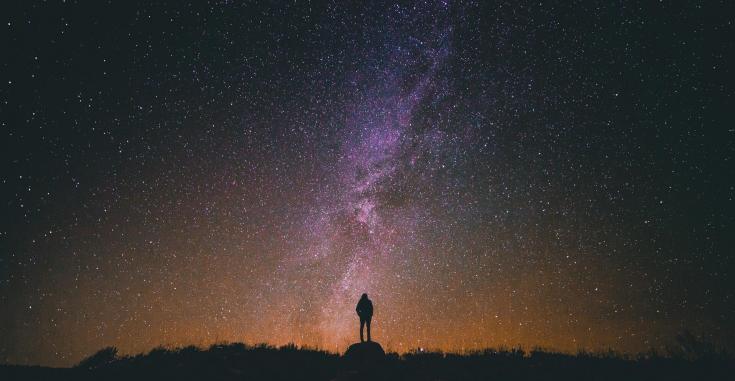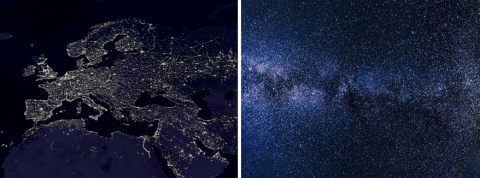Night Light: the unexpected potentials of a dark night sky

Satellite images of Earth show a continent covered in light. Some 99% of the EU population live in areas where the night sky is above the threshold set for polluted status. The trend is getting even worse as more and more people in Europe live in cities and as public safety arguments for more public lighting becomes stronger.
As a result, when the sky is clear, urban dwellers see very few stars as there is too much light around, from roads, buildings to name but a few sources of light.
At the same time, we all nurture fond memories of summer evenings in the countryside when the sky seems to have opened up and we can’t take our gaze away from myriads of stars.
Besides preventing us and our kids from contemplation of the night sky, light pollution has a number of additional negative impacts on humans, the biodiversity and ecosystems. Artificial lights can cause insomnia and depression in humans. They profoundly disturb animals and plants and alter natural behaviours like reproduction, nourishment, sleep and protection from predators. In addition, unchecked lighting is a huge consumer of electricity.
Solutions
The EU has been taking measures to address the problem. As an example, the revised Green Public Procurement Criteria for Road Lighting and Traffic Signals envisage to reduce light pollution and to decrease energy consumption.
The Interreg Europe project Night Light addresses the issue of light pollution and has identified interesting good practices in a number of regions. In Gorenjska County (Slovenia) action was triggered based on a National Strategy on Energy Efficiency and on one of the first dedicated pieces of legislation on light pollution. Since then, several initiatives have been developed in this region. Samso Island (Denmark) incorporated action on light pollution in their overall energy transition approach.
Smart lighting for cultural heritage
The Dark Sky Association from Slovenia switched to nature-friendly lighting of cultural heritage sites through installing a new type of reflectors developed within a LIFE+ project. The purpose of the reflector is to illuminate cultural heritage sites properly but sparingly. The reflector has an aperture adapted to the shape of the building and an UV filter. The change of lighting for one specific church costs 9,000 EUR for 13 new lights of max. 150 W replacing the 400 W bulbs. As a result, the brightness of the façades has decreased from 7 cd/m2 to below the legal limit of 1 cd/m2. Electricity consumption decreased by an average of 65%.
Image credit: Simon Zidar
As pointed out by Tamara Mravinec from the Night Light project, 'moderate and proper lighting lowers the cost of electricity, has a positive effect on human health, does not endanger nocturnal animals and allows us to enjoy the starry sky'.
Additionally, Technical Guidelines on Nature-friendly Lighting of Objects of Cultural Heritage (churches) have been drafted with the Slovenian National Commission for UNESCO. These contain a number of recommendations targeted at public authorities and the managers of cultural heritage sites. As explained by Andrej Mohar from the Dark Sky Association ‘it is expected that this cooperation is also the first step towards international standardization in the field of lighting of cultural heritage objects’.
Smart lighting for nature
The Municipality of Jezersko, Slovenia introduced dynamic lighting in a protected area, a type of smart lighting at the Planšar Lake in the Gorenjska region. As the place is a protected area, the shapes of the lamps had to be aligned with the standards of the Institute for the Protection of Cultural Heritage of Slovenia. Being in the vicinity of a Natura 2000 site and a cultural protected landscape, new lighting includes a system for controlling illumination of the road and a separate reflector lighting for the ski tracks. Road lighting goes down to 10-20% during absence of traffic and is completely switched off for the ski track. The lighting upgrade cost 35,000 EUR for 13 LED lamps with integrated sensors and controllers and 7 reflectors for cross-country skiing. As a result, electricity consumption decreased by 2.383 kWh per year.

Image credit: Aleš Petrič from Bakster Production
As visible on the pictures and as highlighted by Ms. Mravinec, 'dynamic public lighting changes luminosity, direction and intensity of colours according to the needs of the location where it is placed, all with the help of ICT technology'. Helena Cvenkel from the Regional Development Agency of Gorenjska underlined that 'the pilot investments have a positive impact on both the environment and climate and show the way to further improvement of public lighting in other 18 local communities in Gorenjska region. They contribute to the positive image of dynamic lighting and have positive impact on the preservation of Natura 2000 areas'.
Dimming an entire island
The Municipality of Samso (Denmark) had a slightly different motivation than Gorenjska Region. The island is often given as an example for green and circular transition and is known for its ambitious energy efficiency approach. In this framework, they replaced the lighting in one village with LED lighting. The shift to LED has been expanded to the whole island. The 380,000 EUR investments are repaid by energy savings. Besides reaching the objective of reducing light pollution on the island, the initiative has reinforced Samso’s position as a role model in the green transition.
Factors of success
The above examples share several key factors of success. Awareness of the importance of dark skies and the negative effects of light pollution is the most important one. A dedicated national or regional strategy and legislation on light pollution does also trigger action. Obligatory energy efficiency strategies and associated energy savings measures play a role too. International cooperation in the context of different EU funding opportunities (Interreg programmes, LIFE+ etc.) are a motivator for action. Gorenjska region has reported numerous inspirations from other Night Light partners such as how to raise awareness and become a Dark Sky area; how to work on standards and long-term commitments; strategy and policy making; and the link with cultural and natural heritage featured in the first two examples. The region has also been inspired from partners on strengthening the link between dark skies and sustainable tourism.
What can other regions and cities learn from the above presented experiences?
The overall regional approach in Gorenjska region and the two good practices are highly transferable. The example of nature-friendly lighting in cultural heritage sites could be of interest to European regions with rich cultural heritage which would like to review and optimise the approach to lighting of cultural buildings linking it to the issue of light pollution and energy savings.
The example of a dynamic, smart lighting in natural parks is a concrete demonstration of a technical solution adapted to a nature protected area and the functionality of the place. In addition to decreasing light pollution, both examples lead to significant energy savings while maintaining the aesthetic value of the lighting infrastructure. The Samso Island shift to LED is an illustration of how actions related to lighting have a double benefit of reducing the light pollution and being part of the local energy transition.

